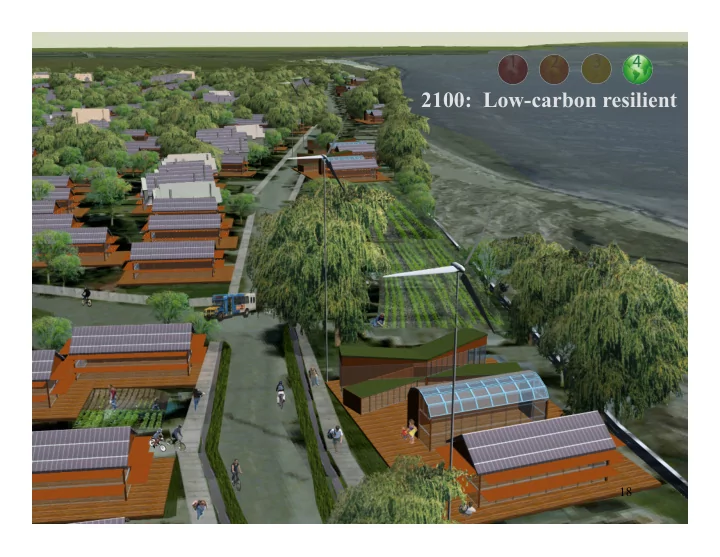

Coastal Neighbourhoods 2100: Low-carbon resilient 2100: Dike Adaptation 2100: Wall Adaptation Existing 2100: Storm surge Condition (3.48m) 18
Capital Cost of UBC Buildings $120,000,000 Total Construction Cost (2011 $100,000,000 UBC $80,000,000 comparable buildings dollars) CIRS $60,000,000 $40,000,000 $20,000,000 $0 0 50,000 100,000 150,000 200,000 250,000 300,000 Floor Area (sq.ft)
Total Cost of Ownership CIRS vs. minimum standard Millions of 2011 $ 25 YR NPV 50 50000000 Capital Renewal CDN$ NPV 2011 40 40000000 30 30000000 Operating Costs 20 20000000 Construction 10000000 10 Cost (2011) 0 Best Practice (LEED Beyond Best Practice Gold) (CIRS)
CIRS research projects • Behavioural research (6 projects) • Lifecycle assessment and costing • PREOE and POE work • Occupant to inhabitant: engagement processes • Building performance (ventilation, air quality, acoustics, energy, water) • Decision-making tools and processes • IT and sustainability • Smart energy system work • Community engagement in Decision Theatre • Residential sector applications and manual • Regenerative neighbourhoods project • CRC2 in behavioural sustainability
3,000 points of monitoring (excluding F/A) • Total electricity • Electrical panels (including plug loads) • Solar PV • Solar hot water • Domestic water supply • Rainwater harvesting • Reclaim water • Storm-water redirected to aquifer • Available day-light • Indoor CO2 and VOC • Weather-related (RH; CO2; air temp) • Space controls (radiators; air temp) • Window status and controls • F/A • Digital video monitors
Behavioural research in CIRS • Recycling behaviour in CIRS • Recycling and signage • Mood and creativity: CIRS and Kenny • Water tasting: CIRS and Kenny • Learning outcomes in CIRS • Reactions to efficient lighting
Recycling Behaviour in CIRS 100 5 80 Proper Disposal (%) Ratings of Environmental 4 Consciousness 60 3 40 2 20 1 0 General SUB CIRS SUB CIRS Location Location
Recycling and Signage study 3000 2.5 Inverse Efficiency Score * Sensitivity Index (d') * 2500 2 2000 1.5 1500 1 1000 0.5 500 0 0 Picture Icon Just Yes Yes/no Image Type Sign Type
Emerging Research Agenda • Building performance evaluation • Integrated approach to building lifecycle • Regenerative sustainability lens
Sustainable Building Evaluation quantitative Building Performance modeling measurement Post- Pre- Pre- Post- Occupancy Occupancy Evaluation Evaluation qualitative
Building Lifecycle Integrated Design Design Process (IDP) D Lean & Green Construction Construction O C Integration Lifecycle Commissioning Planning C Continuous Operations Optimization
Sustainability lens • Need for consistent and comprehensive sustainability evaluation framework: should incorporate LCA, LCC in regenerative context • Able to be applied in all four stages of building lifecycle • Go beyond the building shell: neighbourhood/precinct
UBC Sustainability Initiative
UBC Sustainability Initiative Academic Agent of Change Academic Campus as Living Laboratory Operational Operational
Campus as sustainability test-bed Universities uniquely suited for this role • Single (owner-)occupiers • Public mandate • Teaching • Research Develop integrated campus-scale systems • Demonstration and research • Engage and train students; develop new curricula and programs
UBC Campus as a Living Lab
UBC Campus Steam System ~14 million sq. ft. ~270 core buildings ~ 300 hectares UBC’s Climate Change goals (Mar, 2010) Size of energy challenge: • achieved Kyoto targets (-6%) for core • eliminate fossil fuels academic buildings in 2007 (with 35% • no new electricity transmission lines growth in floorspace) to campus 100 • New targets: • ~35% growth in research and 80 - 33% by 2015 CIRS 60 residential floorspace by 2030 - 67% by 2020 40 20 - 100% by 2050 0 2007 2015 2020 2050
Living Lab Roadmap 2015 2020 2050 33% GHG Reduction 67% GHG Reduction 100% GHG Reduction Supply: New clean energy sources: 8.5MW Clean Energy: Bioenergy R&D Project (9%) Ocean, Waste, Aquifer? Biomass II, Triumf? (23%) Steam to Hot water conversion Extend District Heating Demand: (completion) (5%) system to all campus buildings Steam to Hot water Continuous Optimization; BC conversion (start) (17%) Continuous Optimization Hydro Self-Sufficiency (6.5%) Continuous Optimization; New Buildings: energy neutral Pulse Energy (10%) New Buildings: Low temperature; energy neutral New Buildings: Low Transport changes temperature and energy Smart Energy System
Current Signature Projects
Recommend
More recommend